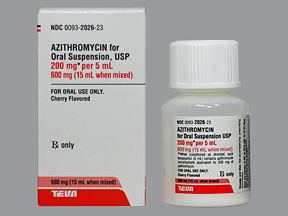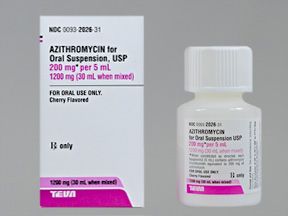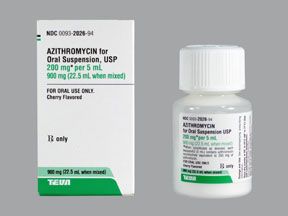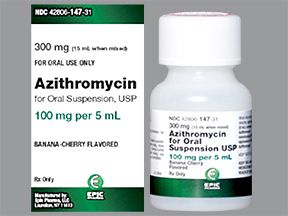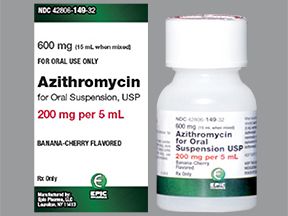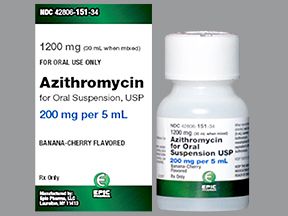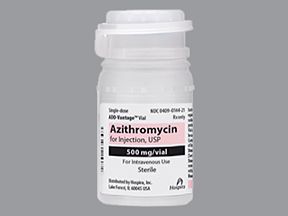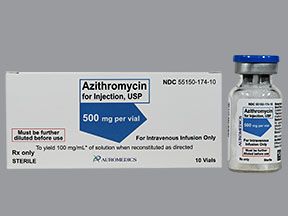- Azithromycin oral tablet is available as both a generic and brand-name drug. Brand name: Zithromax.
- Azithromycin comes as a tablet and suspension, both of which are taken by mouth. It also comes as eye drops, as well as an intravenous form that’s given by a healthcare provider.
- Azithromycin is used to treat infections caused by certain bacteria.
- Abnormal heart rhythm warning. In some people, azithromycin may cause an abnormal heart rhythm called QT prolongation. The risk of this condition is increased if you already have certain problems with your heart rhythm or if you take other drugs that may also cause QT prolongation. The risk is also increased in older adults. QT prolongation is very serious, and it may even be fatal in some cases. If you have any problems with your heart rhythm, tell your doctor before taking azithromycin. Also tell your doctor about all other medications you’re taking before starting this drug.
- Antibiotic-associated diarrhea warning. Almost all antibiotics, including azithromycin, can cause diarrhea. The drug may cause mild diarrhea to severe inflammation of your colon, which can cause death. Call your doctor if you have severe diarrhea or diarrhea that lasts after you stop taking this drug.
- Liver problems warning. In rare cases, this drug can cause liver problems. If you already have liver disease, it could worsen your liver function. During treatment with azithromycin, your doctor may need to monitor your liver function. They may do blood tests to check how well your liver is working. If your liver isn’t working well, your doctor may have you stop taking this drug.
- Myasthenia gravis warning. Azithromycin can worsen symptoms of myasthenia gravis, a condition that causes symptoms such as weakness in muscles used for movement. Azithromycin can also cause a similar condition called myasthenic syndrome. If you have myasthenia gravis, be sure to tell your doctor before taking azithromycin.
Azithromycin is a prescription drug. It’s available as:
- an oral tablet
- an oral suspension
- an eye drop
- an intravenous (IV) form (given by a healthcare provider)
The oral tablet is available as a generic drug as well as the brand-name drug Zithromax. Generic drugs usually cost less than the brand-name version. In some cases, they may not be available in all strengths or forms as the brand-name drug.
Why it’s used
Azithromycin is used to treat infections caused by certain bacteria. The drug should not be used to treat infections caused by viruses, such as the common cold. Azithromycin may be used in combination with other antibiotics when it’s used to treat infections such as mycobacterium avium complex and some sexually transmitted infections (STIs).
How it works
Azithromycin works by stopping bacteria from multiplying (making more bacteria). This action kills the bacteria and treats your infection.
Azithromycin oral tablet doesn’t cause drowsiness, but it can cause other side effects.
More common side effects
The more common side effects of azithromycin oral tablet can include:
- diarrhea
- nausea
- abdominal (belly) pain
- vomiting
- headache
If these effects are mild, they may go away within a few days or a couple of weeks. If they’re more severe or don’t go away, talk to your doctor or pharmacist.
Serious side effects
Call your doctor right away if you have serious side effects. Call 911 if your symptoms feel life threatening or if you think you’re having a medical emergency. Serious side effects can include:
- Liver problems. Symptoms can include:
- tiredness or weakness
- loss of appetite
- pain in your upper abdomen (belly)
- dark urine
- yellowing of your skin or the whites of your eyes
- QT prolongation, which can cause a fast or irregular heart rhythm. Symptoms can include:
- feeling fluttering in your chest
- gasping while sleeping
- fainting
- Allergic reactions. Symptoms can include:
- trouble breathing
- swelling of your face, lips, tongue, or throat
- severe skin reactions, such as Stevens-Johnson syndrome, acute generalized exanthematous pustulosis (AGEP), or toxic epidermal necrolysis, which can cause symptoms such as red, blistering skin or skin sloughing (shedding dead skin cells)
- Diarrhea that’s caused by bacteria called Clostridium difficile (C. diff). In addition to diarrhea, symptoms can include:
- abdominal (belly) pain
- nausea
- reduced appetite
- Infantile hypertrophic pyloric stenosis (narrowing or blocking in part of the digestive system in newborns). Symptoms can include:
- vomiting after eating
- irritability with feeding
- lack of weight gain
If you have an allergic reaction, call your doctor or local poison control center right away. If your symptoms are severe, call 911 or go to the nearest emergency room. Don’t take this drug again if you’ve ever had an allergic reaction to it. Taking it again could cause death.
Disclaimer: Our goal is to provide you with the most relevant and current information. However, because drugs affect each person differently, we cannot guarantee that this information includes all possible side effects. This information is not a substitute for medical advice. Always discuss possible side effects with a healthcare provider who knows your medical history.
Azithromycin oral tablet can interact with other medications, vitamins, or herbs you may be taking. An interaction is when a substance changes the way a drug works. This can be harmful or prevent the drug from working well.
To help avoid interactions, your doctor should manage all of your medications carefully. Be sure to tell your doctor about all medications, vitamins, or herbs you’re taking. If you have questions about whether a drug you’re taking might interact with azithromycin, talk to your doctor or pharmacist.
Examples of drugs that can cause interactions with azithromycin are listed below.
Interactions that increase your risk of side effects
Taking azithromycin with certain medications raises your risk of side effects from these drugs. Examples of drugs that interact with azithromycin include:
- Nelfinavir. Taking this antiviral drug with azithromycin may cause liver or hearing problems. Your doctor will monitor you for these side effects.
- Warfarin. Taking this blood thinner drug with azithromycin may increase your risk of bleeding. Your doctor will monitor you closely if you take these drugs together.
Disclaimer: Our goal is to provide you with the most relevant and current information. However, because drugs interact differently in each person, we cannot guarantee that this information includes all possible interactions. This information is not a substitute for medical advice. Always speak with your healthcare provider about possible interactions with all prescription drugs, vitamins, herbs and supplements, and over-the-counter drugs that you are taking.
This drug comes with several warnings.
Allergy warning
This drug can cause a severe allergic reaction. Symptoms can include:
- trouble breathing
- swelling of your throat or tongue
- hives
- severe skin reactions that can cause symptoms such as red, blistering skin or skin sloughing (shedding dead skin cells)
If you develop these symptoms, call 911 or go to the nearest emergency room.
Don’t take this drug again if you’ve ever had an allergic reaction to it. Taking it again could be fatal (cause death).
Warnings for people with certain health conditions
For people with myasthenia gravis: If you have myasthenia gravis, taking this drug may worsen your symptoms. Be sure to discuss your condition with your doctor before taking azithromycin.
For people with certain heart problems: If you have an abnormal heart rhythm, including a condition called QT prolongation, taking this drug can increase your risk of having an arrhythmia that may be fatal. People with decompensated (uncontrolled) heart failure are also at risk. Ask your doctor if this drug is safe for you.
Warnings for other groups
For pregnant women:
Azithromycin hasn’t been evaluated in clinical studies of pregnant women. However, when used during pregnancy, the drug hasn’t been found to increase the risk of pregnancy loss, birth defects, or other problems.
One study in pregnant rats did show increased risk of fetal death and delays in development after birth. However, most animal studies of the drug haven’t shown any increased risk of birth defects. And keep in mind that animal studies don’t always predict what will happen in humans.
Before taking azithromycin, talk with your doctor if you’re pregnant or plan to become pregnant. This drug should be used only if it’s clearly needed.
For women who are breastfeeding:
Azithromycin does pass into the breast milk of lactating women. Because of this, the drug may cause side effects in a child who’s breastfed. These side effects may include diarrhea, vomiting, and rash.
Before taking azithromycin, talk with your doctor about whether it’s safe for you to breastfeed.
All possible dosages and drug forms may not be included here. Your dosage, drug form, and how often you take the drug will depend on:
- your age
- the condition being treated
- how severe your condition is
- other medical conditions you have
- how you react to the first dose
Forms and strengths
Generic: Azithromycin
- Form: oral tablet
- Strengths: 250 mg, 500 mg, 600 mg
Brand: Zithromax
- Form: oral tablet
- Strengths: 250 mg, 500 mg
For bronchitis
Adult dosage (ages 18 years and older)
Typical dosage is 500 mg once per day for 3 days. Your doctor may also prescribe 500 mg taken as a single dose on day 1, followed by 250 mg once per day on days 2 through 5.
For sinusitis
Adult dosage (ages 18 years and older)
Typical dosage is to take 500 mg once per day for 3 days.
Child dosage (ages 6 months to 17 years)
Typical dosage is 10 mg/kg of body weight once per day for 3 days.
Child dosage (ages 0 to less than 6 months)
This drug should not be used in children who are younger than 6 months.
For skin and skin structure infections
Adult dosage (ages 18 years and older)
Your doctor may prescribe 500 mg taken in a single dose on day 1, followed by 250 mg once per day on days 2 through 5.
For urethritis and cervicitis
Adult dosage (ages 18 years and older)
If your infection isn’t caused by gonorrhea, you’ll typically take a single 1-gram dose. If you are treating a gonorrheal infection, you’ll typically take a single 2-gram dose.
For genital ulcer disease
Adult dosage (ages 18 years and older)
The doctor will typically prescribe a single 1-gram dose.
For acute middle ear infection
Child dosage (ages 6 months to 17 years)
The typical dosage is 30 mg/kg of body weight taken as a single dose, or 10 mg/kg of body weight once per day for 3 days. The doctor may also prescribe 10 mg/kg of body weight on day 1, followed by 5 mg/kg per day on days 2 through 5.
Child dosage (ages 0 to less than 6 months)
This drug should not be used in children who are younger than 6 months.
For community-acquired pneumonia
Adult dosage (ages 18 years and older)
Your doctor may prescribe 500 mg in a single dose on day 1, followed by 250 mg once per day on days 2 through 5.
Child dosage (ages 6 months to 17 years)
Children of this age typically take 10 mg/kg of body weight in a single dose on day 1. Then they take 5 mg/kg once per day on days 2 through 5.
Child dosage (ages 0 to less than 6 months)
This drug should not be used in children who are younger than 6 months.
For mycobacterium avium complex disease
Adult dosage (ages 18 years and older)
For treatment, typical dosage is 600 mg once per day, taken with the drug ethambutol.
For prevention, typical dosage is 1,200 mg once per week.
For pharyngitis or tonsillitis
Adult dosage (ages 18 years and older)
Your doctor may prescribe 500 mg in a single dose on day 1, followed by 250 mg once per day on days 2 through 5.
Child dosage (ages 2 to 17 years)
The typical dosage is 12 mg/kg of body weight once per day for 5 days.
Child dosage (ages 0 to less than 2 years)
This drug should not be used for this condition in children who are younger than 2 years.
Disclaimer: Our goal is to provide you with the most relevant and current information. However, because drugs affect each person differently, we cannot guarantee that this list includes all possible dosages. This information is not a substitute for medical advice. Always speak with your doctor or pharmacist about dosages that are right for you.
Azithromycin is typically used for short-term treatment. It comes with risks if you don’t take it as prescribed.
If you stop taking the drug or don’t take it at all: Your infection may not improve, or it may get worse.
If you miss doses or don’t take the drug on schedule: Your medication may not work as well or may stop working completely. For azithromycin to work well, a certain amount needs to be in your body at all times.
If you take too much: You could have dangerous levels of the drug in your body. This may cause liver damage or an irregular heart rhythm.
If you think you’ve taken too much of this drug, call your doctor or local poison control center. If your symptoms are severe, call 911 or go to the nearest emergency room right away.
What to do if you miss a dose: Take your dose as soon as you remember. But if you remember just a few hours before your next scheduled dose, take only one dose. Never try to catch up by taking two doses at once. This could result in dangerous side effects.
How to tell if the drug is working: Your infection should go away.
If you take too much azithromycin, you could have dangerous levels of the drug in your body. This may cause liver damage and irregular heart rhythm. If you think you’ve taken too much of this drug, call your doctor or local poison control center. If your symptoms are severe, call 911 or go to the nearest emergency room right away.
General
- You can take this drug with or without food. However, taking it with food may help reduce certain side effects, such as upset stomach and nausea.
Storage
- Store this drug at room temperature between 68ºF and 77ºF (20ºC and 25ºC). You can briefly store it between 59ºF and 86ºF (15ºC and 30ºC).
- Don’t store this medication in moist or damp areas, such as bathrooms.
Refills
A prescription for this medication is refillable. You should not need a new prescription for this medication to be refilled. Your doctor will write the number of refills authorized on your prescription.
Travel
When traveling with your medication, follow these tips:
- Always carry your medication with you, such as in your carry-on bag.
- Don’t worry about airport X-ray machines. They can’t hurt your medication.
- You may need to show airport staff the pharmacy label for your medication. Always carry the original prescription-labeled box with you.
- Don’t put this medication in your car’s glove compartment or leave it in the car. Be sure to avoid doing this when the weather is very hot or very cold.
A class of drugs is a group of medications that work in a similar way. These drugs are often used to treat similar conditions.
Azithromycin belongs to a drug class called macrolide antibiotics. Antibiotics are drugs used to treat infections caused by bacteria. Each antibiotic only works against infections caused by certain types of bacteria, so there are many classes and types of antibiotics.
Macrolide antibiotics are typically used to treat infections such as strep throat, syphilis, Lyme disease, and respiratory infections. They’re also used to treat infections caused by organisms called mycoplasma, which can cause conditions such as pneumonia. The other macrolide antibiotics available in the United States are clarithromycin and erythromycin.
There are other drugs available to treat your condition. Some may be better suited for you than others. Talk to your doctor about other drug options that may work for you.
Q: What’s the difference between azithromycin and amoxicillin?
A: One difference is that while both of these drugs work by killing bacteria, they do it in different ways. Some of the other differences between these two drugs include what drug class they’re in, what conditions they’re used to treat, and how often they’re taken.
Azithromycin belongs to the class of drugs called macrolide antibiotics, as described in this article. Amoxicillin belongs to a class called beta-lactam antibiotics. This is a large class that includes drugs such as penicillin.
Azithromycin and amoxicillin can be used to treat several of the same conditions. These include bronchitis, sinusitis, strep throat, pneumonia, ear infections, skin infections, and lower respiratory infections. However, they have differences.
Azithromycin can also be used to treat gonorrhea, mycobacterium avium complex, and pelvic inflammatory disease. And amoxicillin can also be used to treat urinary tract infections and H. pylori infections, which can cause stomach ulcers.
The greatest difference to you may be how often you need to take them. Azithromycin may be taken once per day for 1 to 5 days, depending on the condition being treated. On the other hand, amoxicillin is often taken two or three times per day for 10 to 14 days.
— The Medical News Today Medical Team
Answers represent the opinions of our medical experts. All content is strictly informational and should not be considered medical advice.
Disclaimer: Medical News Today has made every effort to make certain that all information is factually correct, comprehensive, and up to date. However, this article should not be used as a substitute for the knowledge and expertise of a licensed healthcare professional. You should always consult your doctor or other healthcare professional before taking any medication. The drug information contained herein is subject to change and is not intended to cover all possible uses, directions, precautions, warnings, drug interactions, allergic reactions, or adverse effects. The absence of warnings or other information for a given drug does not indicate that the drug or drug combination is safe, effective, or appropriate for all patients or all specific uses.













